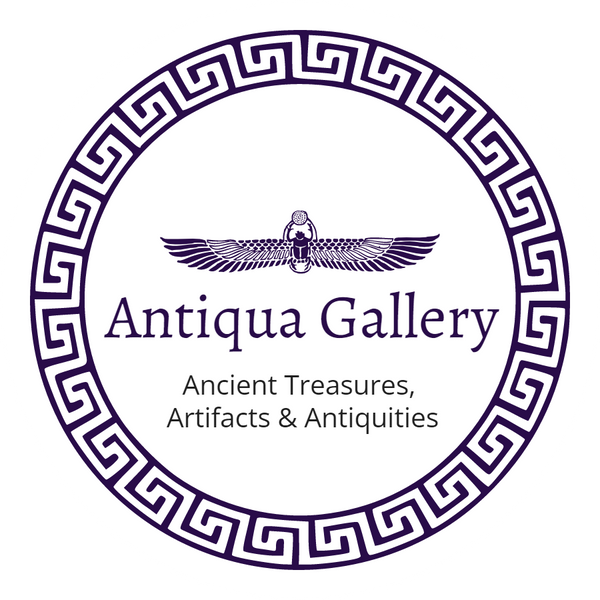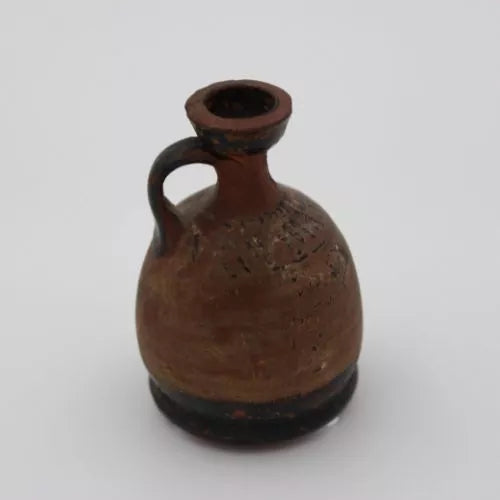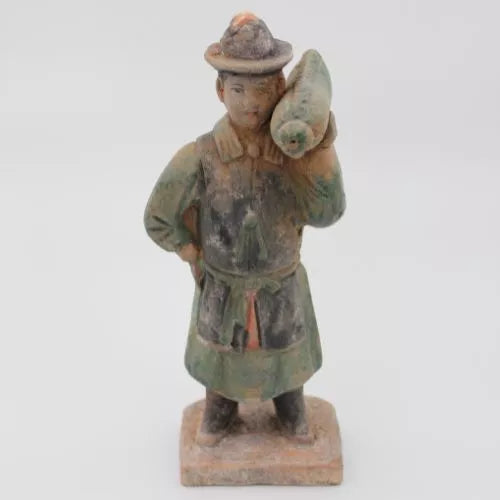Here you'll see most of the antiquities sold on this website from around August 2021.
Classical Antiquities
Late Imperial Lamp with Chi-Rho Monogram
A very fine late imperial oil lamp from the Tunisian roman camps. The discus of the lamp are decorated with simple geometrical designs, which is one of the earliest forms of christograms.
The base of the oil lamp bears the palm branch mark.
Provenance: Ex. Deceased Estate, Copenhagen.
Culture & Year: Roman, Tunisia, 350 - 500 AD.
Litterature Reference: www.romulus2.com & Kelsall, P. (2018). Lighting the Ancient World.

Coptic Pilgrim Flask with saint-Menas
An interesting Coptic pilgrim flask (ampullae) made in Byzantine Egypt. The motive represents Saint-Menas with two camels which are associated with the pilgramage that was created around the egyptian soldier.
Provenance: Ex. deceased estate in Copenhagen.
Culture & Year: Coptic, 400 - 600 a.d.
Reference: See the metmuseum for similar.

Discus Fragment with Pegasus (Bailey Type C)
Discus fragment from a Roman Imperial Period oil lamp. The motive represents Pegasus.
Around the reign of Augustus, 27 BC - 14 AD, art made new artistic heights. And even the oil lamps became more than just simple utility products - they became artworks, and many manufacturers placed marks or signatures on the lamps. It is in this period, that the early imperial lamps became popular.
This discus i very likely an early imperial oil lamp of the Bailey Type C category. This type was most popular throughout the first two centuries AD.
Provenance: Ex. deceased estate in Copenhagen.
Litterature Reference: Lighting the Ancient World, D. Knell; 2018

Oil Lamp Handle with Lunar Ornament
A large handle, which is hollow at base, decorated with a lunar crescent ornament. The handle has been broken off where body joined handle.
Provenance: Ex. deceased estate in Copenhagen.
Litterature Reference: The Cesnola Collection of Cypriot Art, Terracotta Oil Lamps, C. S. Lightfoot; 342

Roman Stone Fragment with Letters
A beautiful stone fragment with the letters N and I on the front. Perfect to have on the corner of the desk or in the window sill.
Provenance: Private Collection, Hellerup, Denmark.
Culture & Year: Roman, 100 BC. - 100 AD.

Fragment of Greek Kratér Vase
A beautifully painted fragment of a greek cratér vase. The piece was part of a large black-figure vase and from either the base or mouth.

Roman Venus Figure in Terracotta
An interesting terracotta figure of the goddess Venus. You can quite easily see the details of the face and hair. The figure is presented nicely on a nice glasbox.

Roman Bronze Figure of a Lar
The Lare figures were gods of the household - they were guardians. The Lares were at the center of the Roman domestic religion and it was their job to maintain order in the house.
The figure is holding a round object in its left hand and a pointy object in its right hand. It has one wing left on his right shoulder.
Culture & Year: Roman, Approx. 0 AD.

Lekanis from Attica
An absolutely stunning little attic kylix with a lid. It's been beautifully detailed with a simple geometric pattern, with dots, and small lines.
Culture & Year: Attic, 5th century BC.
Provenance: Ex. Deceased Estate, Alleroed, Denmark.

Gnathian Oenochoe
A beautiful Gnathian Oenochoe from Gnathia, the apulian region of Italy.
Culture & Year: Gnathian, Eastern Apulian, 4th Century BC.

Roman Oil Lamp
A small roman oil lamp from around 150 b.c. - 200 a.d. Private Collection, Hellerup.
Culture & Year: Roman, 150 b.c. - 200 a.d.

Roman Oil Lamp with Pegasus from El Djem, Tunisia
A moulded light-brown pottery oil lamp from the Tunisian city of El Djem. The motive on the lamp is showing the winged horse, Pegasus. Ex. deceased estate, Copenhagen.
Culture & Year: El Djem, Tunisia, 146 b.c. - 200 a.d.

Roman Mid-Imperial Oil Lamp with Isis facing Serapis
A beautiful moulded oil lamp from the Mid-Imperial period of Rome. On the discus there is a motive of Isis (left) facing Serapis (right). The nossle is heart-shaped and there are a simple pattern on the rim of the discus. Ex. deceased estate, Copenhagen.
Litterature Reference: Lighting the Ancient World, D. Knell; 2018
Culture & Year: Roman North-African Colonies of Tunisia, 175 - 250 a.d.

Mid-Imperial Oil Lamp, Discus with Soldier
A beautiful mould-made mid-imperial oil lamp. The motive on the disc depicts a figure holding a spear.
The nozzle of the lamp is either U-shaped or a Semi-Circle which are two quite common nozzle shapes of mid-imperial oil lamps from 150 AD - 400 AD.
The rather simple decoration of the rim, combined with the nozzle, indicates it is from the earlier years of the mid-imperial oil lamps (150 AD - 250 AD-ish).
Based on the above it is a Bailey Type P oil lamp.
There is a slim chance that it's a Bailey Type Q variation, however these were produced in the later part of the mid-imperial period, and often had highly decorated rims. The discus decorations were more complex and intricate, with scenes of theatres, public buildings and more imaginative images.
Provenance: Ex. deceased estate in Copenhagen.
Culture & Year: Roman Mid-Imperial, 150 - 250 a.d.

Corinithian Aryballos
A beautiful corinthian aryballos with a motive you can just skim. Small chips in at the core of the piece. Private collection, previously from Danish Auciton House.
Culture & Year: Corinthian, 700 – 500 b.c.

Late Imperial Oil Lamp
A beautiful mould-made late imperial oil lamp with fine details. Private collection, Hellerup.

Byzantine (Syro-Palestine) Oil Lamp with Greek Inscriptions
A beautiful oil lamp from around the 5th - 7th century AD See romulus2.com for references and Lighting the Ancient World, D. Knell; 2018.

Oil Lamp
A pleasant roman oil lamp from around 100 a.d. – 400 a.d.. You can still see the finely made pattern on the top, however it has been worn a bit.
Year: Roman Empire, 100 a.d. – 400 a.d.

Roman Glass Bottle
An amazing glass flask from the Roman empire. A small piece has broken off from the tip. The iridization has a golden/silver color.

Greek Cup with Spiral Pattern
An interesting cup which is definetly from the greek culture, however I cannot pinpoint the exact one myself. It was used for collecting water, or wine so that it could be poured into another vase or cup.
Provenance: Ex. deceased estate, Copenhagen.
Culture & Year: Greek, 800 BC. - 100 BC.

Near-Eastern Antiquities
Syrian Terracotta Figure
A beautiful near eastern terracotta figure, acquired from a deacese estate in Denmark, before this it was at a Bonham's auction.
Litterature Reference: Collecting Antiquities, Charles Ede; 1976
Culture & Year: North-Syrian, First Millennium B.C.
Provenance: Private Collection, previously Bonhams Auction

Egyptian Antiquities
Large Late Period Ushabti
A very fine egyptian ushabti in turqouise faience, from the late period. The dorsal pillar and trapezoidal base is quite typical for ushabtis of this period.
The hieroglyphs on the front of the figure are most likely inscriptions of various lines from chapter 6 of the Book of the dead.
Provenance: Ex. Deceased Estate, Hellerup. Acquired in the 1950's.
Culture & Year: Egypt, Late Period (664 - 332 BC.)

Egyptian Nefertum Votive Bronze Figure
Here you see a very beautiful ancient egyptian votive bronze figure of the god Nefertum. He is seen wearing lotus blossom atop his head and in a striding position. You can read a lot more about the god Nefertum at the MetMuseums website.
You can just skim the facial details, aswell as the arms, legs and lotus blossum on his head.
Provenance: Ex. Deceased Estate, Hellerup. Acquired in the 50's.
Culture & Year: Egypt, Late Period (664 - 332 BC.)

Egyptian Steatite Scarab with Hieroglyph Inscriptions
A beautiful egyptian steatite scarab in very good condition with Hieroglyph inscribtions.
The hieroglyph in the middle right position is an 'm' The second sign from the bottom is most likely a reed sign and represents the letter 'i'.
Provenance: Ex. private collection, Hellerup, Denmark.

Djed Faience Amulet
An incredibly well-kept Djed Amulet from the New Kingdom Egypt.
The Djed-pillar is made of a bright blue faience.
The amulet symbolised permanence and was used as a funerary amulet to connect the deceased to Osiris.
Provenance: Ex. deceased estate in Hellerup, acquired in Egypt in the 50's.
Year & Period: 1550 b.c. – 1070 b.c., New Kingdom
Littérature Reference: Friedman, Gifts of The Nile – Ancient Egyptian Faience, 1998

Bes Faience Amulet
A beautiful Bes faience amulet with green inlays in the blue faience. Ex. deceased estate, Hellerup.
Culture & Year: Egyptian, 1567 b.c. - 664 b.c.
Literature Reference: Friedman, Gifts of the Nile - Ancient Egyptian Faience

Egyptian Oil Lamp
A beautiful oil lamp from Egypt under roman rule. The motive on the top represents a frog – the hole is the head and the two other representations are legs.
The frog had great symbolic meaning in Egypt – it represented life and fertility. The longer into Romes dominion of Egypt the less meaning it most likely had. Private collection, Fredericia, Denmark.
Culture & Year: Egyptian, 30 b.c. – 400 a.d.

Egyptian-Greek Apis Bull Head
A beautiful greek egyptian terracotta apis bull head bust. Ptolemaic period - around 305 BC to 30 BC. Private Collection, Hellerup.

Egyptian Brown Stone Ushabti
This is a fine little ushabti made of a light brown stone. It's purpose was to help the dead in his/hers next life.

Egyptian Faience Horus Amulet
Horus was son of Isis and conceived after Osiris was resurrected. He would later on avenge his father's death - therefore he was a symbol of victory and kingship.

Pre-Columbian Antiquities
Pre-Columbian Ritual Spoon from Peru
A beautiful and very interesting Peruvian ritual spoon. The spoon is made in fine dark brown clay and has been made with a face in the handle. It also has a receptacle with small stones inside, so when shook it makes a sound.
Culture & Year: Peruvian, 500 - 800 AD.
Provenance: Ex. deceased estate of Nysøe, Acquired in the 1880's on travels to South-America.

Pre-Columbian Head from Mitla, Mexico
Mitla is a Meso-American archaeological digsite in Oaxaca, the southern Mexico. The Zapotecs was the dominant culture in this area till 900 a.d. Then the Mixtecs arrived and dominated till around 1500 a.d.
This head is an early Mixtecan piece with very clear facial details.
Provenance: Ole Hammer Collection. Zoologist who collected all of his pieces in the 1950’s on his travels to South-America. Now most of his collection is in the danish museum ‘Holstebro Art Museum’.
Culture & Year: Mitla, Mexico, 900 a.d. – 1100 a.d.

Pre-Columbian Head with Headdress from Teotihuacan
An interesting little pre-columbian head from Teotihuacan. The figure is wearing a large headdress, with earrings.
Culture & Year: Teotihuacan, 200 - 700 AD.
Provenance: Ex. deceased estate, acquired by engineer on travels to South-America in the 50's.

Pre-Columbian Pottery Head from Tetihuacan
A very fine and interesting pottery head from Teotihuacan in Mexico. One of the ncient Pre-Columbian cultures largest cities. The figure has large round earrings and a pointy hat with slightly horizontal line-markings.
Teotihuacan became inhabited around 400 BC, and by 400 AD, it was the msot powerful and influential city in the region.
Culture & Year: Pre-Columbian, Teotihuacan, 400 - 800 AD.

Jama Coaque Terracotta Figure
Stand is not fully connected to figure.
Provenance: Private Collection of a danish engineer 'Eigil Ettrup Petersen' - he acquired it on his travels in South-America in the 1950's.
Culture and Year: Jama Coaque, 500 b.c. - 500 a.d.

Pre-columbian Flute from Peru
An amazing pre-columbian flute which originates from Peru. It has a beautifully carved pattern combined with two colours. Instruments in the Pre-Columbian era was almost exclusively used for sacrificial and religious rituals.
Provenance: This artefact is from the Lyngby Collection. A collection of more than 1000 pieces which was found in the basement of a villa in the city Lyngby, north of Copenhagen. Most of the items were identified as stolen and were therefore sent back to the countries of origin. Many of the antiquities however were also sold to collectors and dealers.

Pre-columbian Head from Teotihuacan
Provenance: Danish Estate of Ole Hammer. A large part of his pre-columbian collection is at “Holstebro Kunstmuseum” in Denmark.
Culture & Year: Teotihuacan, 100 b.c. – 400 a.d.

Asian Antiquities
Sawankhalok Pottery Cow
A very fine glazed cow from the city Sawankhalok in the province Sukhotai in Thailand. It has been glazed in a light and dark brown paint.
There is some very detailed spiral patterns made by removing some of the glazing.
Provenance: Ex. deceased estate, Copenhagen.
Culture & Year: 13th c. - 15th c. a.d.

Rare 1 Bath Elephant Opium Weight
A beautiful opium weight representing an elephant on an elongated octagonal base, with two lines drawn around it. The base is 3 steps high.
The Validation mark is on the front left side, however difficult to say what the mark is. Most likely from the Chiang Mai or Chiang Saen - the northern region of Thailand, and part of the Lanna kingdom.
Weight: 1 Baht = 13 Grams
The Lanna kingdom did take the Burmese bird weights into consideration, however kept their own weights, and the weight unit of around 12.2.
The longer and a bit more elongated octagonal base a a look preserved throughout the 1700's til the beginnig of the 1800's, with the mark of either Chiang Saen or Chiang Mai.
Finding elephant weights weighing more than 5 Baht/65 grams is very unusual and exceedingly rare! So keep an eye out for those in the future. Thisis because elephant weights were generally used for smaller quantities.
Sorry for a bit unclear pictures, they will be updated in the future! Otherwise just contact me for pictures or more info on the piece.
Kind Regards,
Theodor Knutzen, Antiqua Gallery
Provenance: Ex. Private Collection, Netherlands.
Culture & Year: Lanna Kingdom - Thailand, 1774 AD.
Litterature Reference: Leif Bering Mikkelsen. Opium Weights - Old Animal-shaped Bronze Weights from Southeast Asia. Commercial, ethnic, symbolic and historical perspectives. 2017.
Heigth: 1.9 cm
Length: 1.7 cm
Width: 1.4 cm

Beautiful and Rare Chiang Mai Elephant Opium Weight on Elongated Octagonal Base
A very interesting and quite rare elephant opium weight from Chiang Mai, northern Thailand. The elephants stands on an elongated octagonal base, with a round dot mark on the front - which indicates the region it's from (Chaing Mai). This round mark might symbolize the Chakra sign.
Provenance: Ex. private collection, Netherlands.

Sawankhalok Pottery Dog
A very fine glazed dog from the city Sawankhalok in the province Sukhotai in Thailand. It has been glazed in a light green color. The face of the dog is smiling and a large tail is curling up the back.
Provenance: Ex. deceased estate, Copenhagen.
Culture & Year: 13th c. - 15th c. a.d.

Sawankhalok Pottery Tiger
A very fine glazed tiger from the city Sawankhalok in the province Sukhotai in Thailand. It has been glazed in a light and dark brown paint, but with a more orange-ish color. There is a crack in the figure around the back of the tiger. Probably happened during the firing process.
Provenance: Ex. deceased estate, Copenhagen.
Culture & Year: 13th c. - 15th c. a.d.

17th Century Buddhistic Figure form Indonesia
A very fine buddhistic figure from Indonesia, about 17th or 18th century AD. It has fine facial details and wearing a traditioal headware. It has a few spots of bronze pattina. The inside of the figure is filled with a cement.

Bronze Figure of Hindu Goddess
A very fine little indian bronze figure, representing the hindu goddess, Pahlavi. She is standing on a simple base, her hips out, while holding a lotus flower.

Ming-Dynasty Terracotta Figure, Attendant
A beautiful and very nicely detailed Ming-Dynasty Attendant wearing a hat and fine green and black robe. Over his left shoulder is a sack of, what I suppose is, food.
This attendant is a very fine example of Ming-Dynasty grave figures. These are beautifully moulded terracotta figures of servants, musicians, animals, soldiers and several other types. In chinese the figures are called, mingqi, and were made to fulfil any desires which the deceased might have in the afterlife.
Culture & Year: Chinese, Ming-Dynasty, 1368 - 1644 AD.
Provenance: Private Collection, Netherlands.

Ming-Dynasty Soldier on Horse
A beautiful soldier on his horse. The figure is made with great detail and beautiful dark-blue and bright blue colors. This soldier is carrying two maces while riding a large horse.

Indonesian Buddhistic Bronze Figure
An interesting buddhistic figure from around the 15th and 16th century AD in Indonesia. Has small hairline crack at neck.

Ming-Dynasty Soldier
This soldier is holding a sword in his left hand against his body. This soldier would protect the dead in the afterlife. It's been painted with a nice combination of green and yellow/brown, classic chinese colours, which are often seen on terracotta figures.
Provenance: Private Collection, Denmark.
Culture & Year: Ming-Dynasty, 1368 - 1644 a.d

Ming-Dynasty Servant
This female servant is holding a bag over her right shoulder and holding a kettle in her left hand. The figure has some beautiful facial details and is standing elegantly with blue clothing.
Provenance: Private Collection, Denmark.
Culture & Year: Ming-Dynasty, 1368 - 1644 a.d

Indian Shiva Figure with Drum
This beautiful and interesting figure is sitting down with, what looks like a drum. The figure represents the god Shiva, which is the most worshiped god in Hinduism. Shiva represents destruction and creation.
Culture & Year: 18th c. - 19th c. a.d.

Ming-Dynasty Zodiac Tomb Figure
This has been glazed in a nice turquoise and darkblue paint. The zodiac figures were also only used for the highest in society.
Provenance: Private Collection, Netherlands.
Culture & Year: Ming-Dynasty, 1368 - 1644 a.d.

Ming-Dynasty Terracotta Figure, Servant
A very fine piece of Ming-Dynasty history. A male servant in a blue glazed robe and a black hat, holding what I believe is a fan.
Culture & Year: Chinese, Ming-Dynasty, 1368 - 1644 AD.
Provenance: Private Collection, Netherlands.










